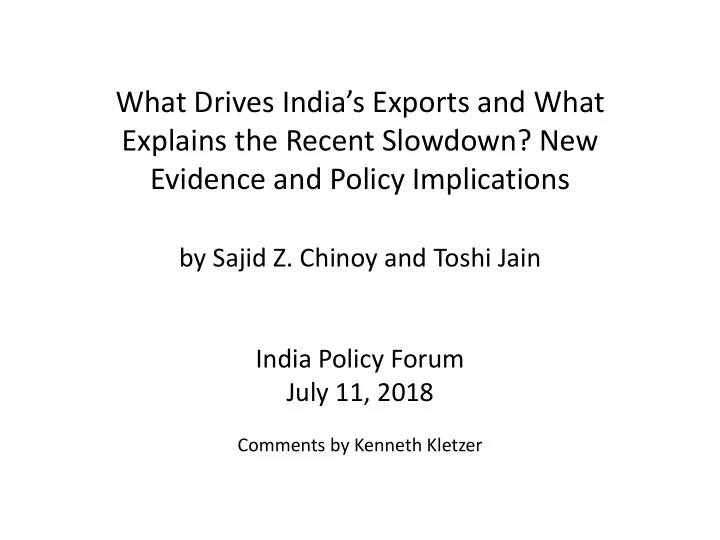

What Drives India’s Exports and What Explains the Recent Slowdown? New Evidence and Policy Implications by Sajid Z. Chinoy and Toshi Jain India Policy Forum July 11, 2018 Comments by Kenneth Kletzer
Export growth slowdown 2003-08: • Rising global trade as share of world GDP • High emerging market growth, but higher for India. • India’s export growth rate much higher than global export growth rate. 2012-17 • Global export growth rate about 3% is lower than before GFC. • India’s share of global exports falls, then returns to 2%. • Terms of trade improvement and real exchange rate appreciation.
Export growth slowdown • The first part of the paper shows that the fall in the growth rate of GDP equals the decrease in the growth rate of value- added in exports between 2003-08 and 2012-17. • However, export growth does not explain the decrease in GDP growth. • Between periods, imports are not constant and net exports rose during 2012-17. • Investment fell significantly from 2003-08 to 2012-17. • In the post-GFC period, investment and imports begin to rise, but export growth remains low.
Empirical analysis • The empirical analysis estimates the elasticities of exports with respect to global GDP growth and the relative prices of tradable goods. • And how these elasticities vary across export product groups. • The estimates of export elasticities show that exports are fairly responsive to real exchange rate movements. • The sub-sample estimates for 2005-11 and 2011-17 are interesting (if significantly different).
Interpreting the slowdown • Since 2000, India’s real exchange rate and the price of oil are closely related. • The real exchange rate steadily depreciates before the GFC and steadily appreciates from 2012 on. • We cannot tell if there is a regime change in regime, or the response to real appreciation and depreciation is asymmetric. • The oil price decline is similar to a capital inflow and can cause a rise domestic demand increasing demand for non-tradables. • The real exchange rate rises, and the non-oil/gold current account surplus falls. • Fine, but we need to know whether production of non-tradable goods increases relative to production tradable good to support the Dutch disease interpretation.
Monetary policy implications • The regressions suggest that real exchange rate movements significantly affect export growth (and net exports). • The observation that falling oil prices have parallel effects to capital inflows on real exchange rates suggests that the RBI ought to intervene in foreign exchange markets, accumulating reserves. • An inflation targeting regime can accommodates this in an open economy (by targeting domestic inflation). • However, the appreciation of the real exchange rate can also be consistent with an inflation objective. Lowering the inflation objective, as suggested in the paper, might be necessary.
What has happened in export industries? • The macro data do not tell us much about the consequences of real appreciation or global demand cycles for exporters. Firm level data might. • The contraction in global growth after the GFC, subsequent recovery of global demand, and real appreciation may each have affected firm level exports at the extensive as well as the intensive margin. • How producer dynamics in export industries varied across sectors would help us understand the importance of the decline in export growth for policy intervention.
• A concern in episodes of real appreciation is that a temporary reduction in industry growth has persistent effects on productivity growth. • The primary mechanism for an impact on productivity growth in the new export industries is likely to be declining entry in exporting. • A related question is whether the allocation of FDI across export industries has changed. • The macro analysis indicates that the slowdown is concentrated on pharma, engineering, and services, but it cannot tell us why.
Recommend
More recommend